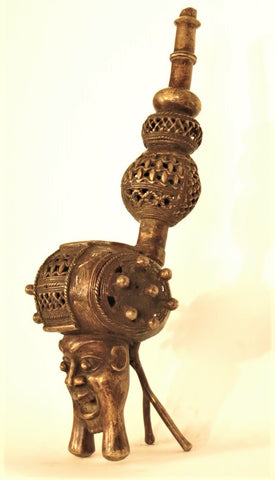ArtTribal.com
Bamum Bronze Pipe
ArtTribal.com
Sold
The northern part of Cameroon has been Islamized and has no sculpture; on the other hand, the savannas of the west, the Grassland, are composed of three ethnic groups with ancestors in common. There are one million Bamileke spread over the southwestern plateaus, in communities that have from 50,000 to 100,000 people; 500,000 Bamenda-Tikar in the north; and, finally, the Bamum in the northwest, with a population of 80,000.
The Grassland was divided into ninety kingdoms governed by a king, the Fon, supported by non-secret societies. In the past, he was believed to be endowed with supernatural powers that allowed him to change into an animal – an elephant, leopard, or buffalo. He ensured the protection of his people and guaranteed the fertility of the fields and the fecundity of the women. The fon was responsible for rituals of planting and harvesting, for the annual festival of the dry season, for the opening of the collective royal hunt, and for expeditions of war. The fon was appointed by his predecessor, who chose him from among his direct heirs, excluding the eldest. Art objects were symbols of position in the hierarchy; their number, the materials from which they were made, and their iconography changed progressively as one descended or ascended the social ladder. In the fon’s palace, next to the ancestral figures and the masks, one would also find headdresses, beaded thrones, bracelets, necklaces, pipes, leopard skins, elephant tusks, swords, commanders’ sticks, fans, dishware, horns, and terracotta bowls.
Product Details:
- Size: 19" х 6" х 7"
- Shipping: $70.00
- Material: Bronze
- Quantity: Sorry, this product is not available
- SKU:





